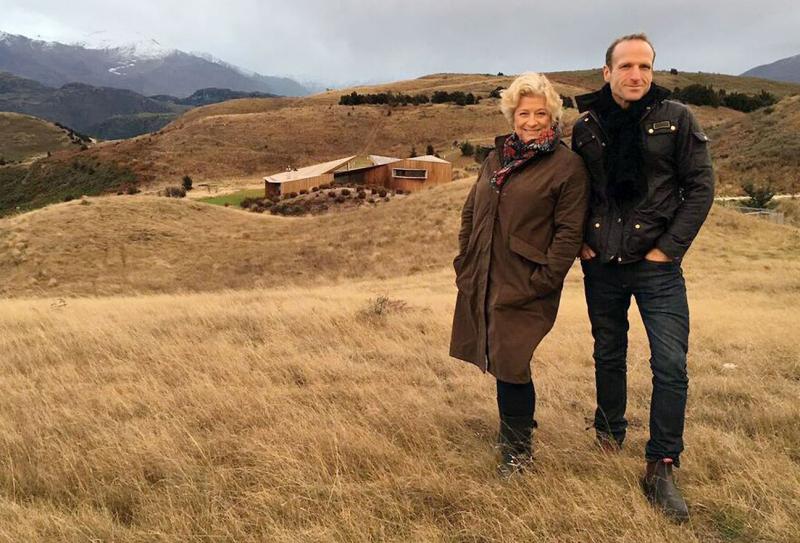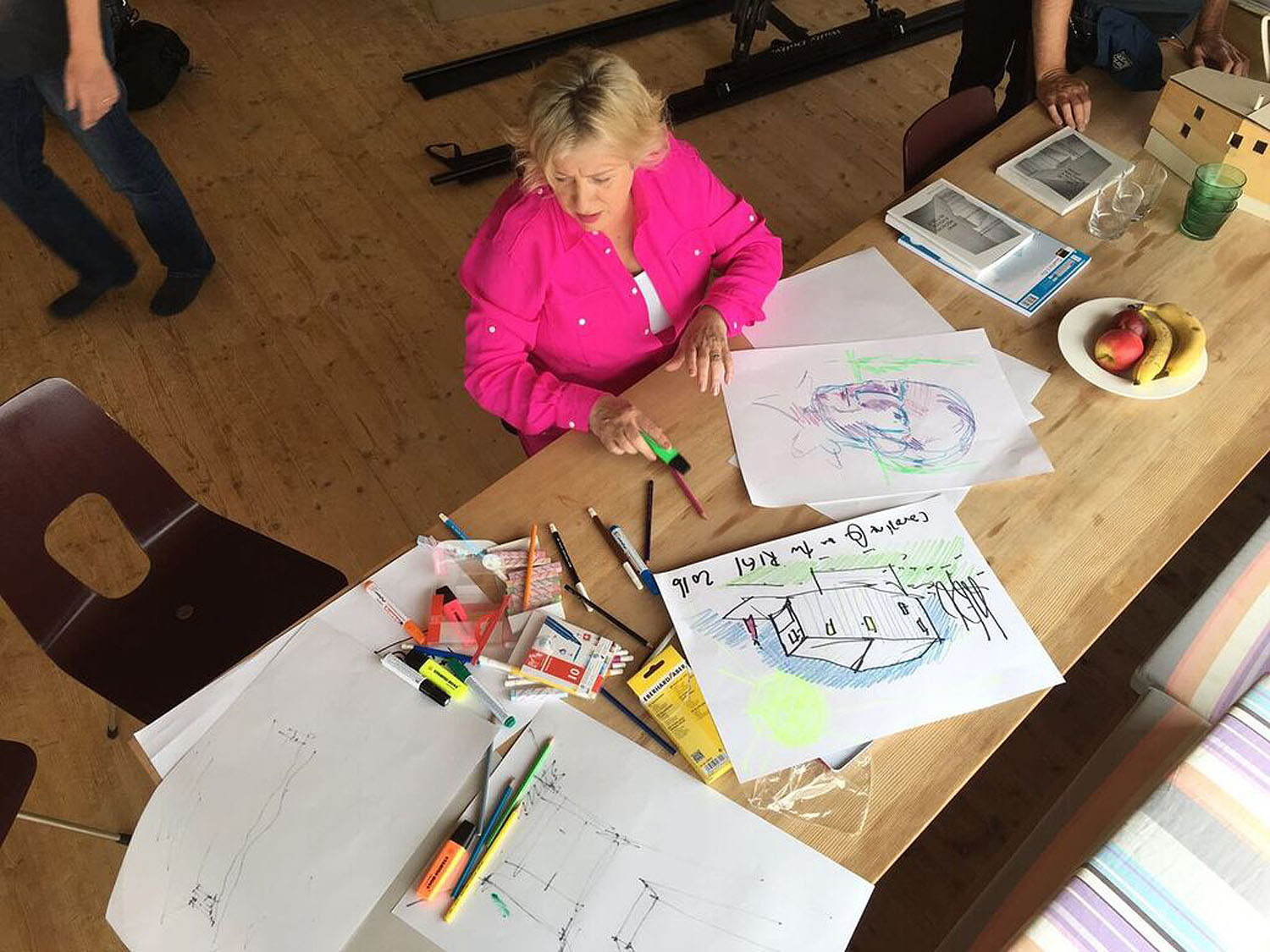The World's Most Extraordinary Homes, BBC Two | reviews, news & interviews
The World's Most Extraordinary Homes, BBC Two
The World's Most Extraordinary Homes, BBC Two
Intrepid presenters seek out amazing architecture at the ends of the earth

This was the first of four programmes looking at houses made of extraordinary materials in various environments, some extreme. We began with "Mountain", and further explorations are promised to "Coast", "Forest" and "Underground".
Caroline Q was the surrogate viewer connecting to us. She nearly toppled over as she explored the potential frisson of the instability of a fragment of the wing of a dismantled Boeing 747 which provided a terrace for the 747 Wing House in the Santa Monica mountains, and an irresistible bounce for our intrepid presenters. The stepping stone external stairs by which the Tucson Mountain Retreat house was reached were yet another challenge, as was the cable car ride – Ms Quentin does not care for heights – to the House on the Rigi (the Swiss mountain much immortalised by Turner a century ago, his dream-like watercolours on view at Tate Britain) some 1650 metres above sea level (pictured below: Quentin draws the landscape at the Rigi House).
 In the midst of a welter of surprised exclamations and a plethora of superlatives, Taylor explained with nifty computer graphics the siting, floor plans, orientation and natural light of the houses so we kind of knew where we were. To say these houses were challenging was an understatement, and all owners confessed that their ambitions had led to major overspend.
In the midst of a welter of surprised exclamations and a plethora of superlatives, Taylor explained with nifty computer graphics the siting, floor plans, orientation and natural light of the houses so we kind of knew where we were. To say these houses were challenging was an understatement, and all owners confessed that their ambitions had led to major overspend.
What we witnessed here in the main was people getting away from their daily lives, and in so doing providing us too with temporary escapism as we journeyed from California to Arizona, South Island New Zealand to the Swiss Alps. None of the quartet of houses in the first programme were or had been full-time habitats for their owners. They were holiday houses or retreats, except for the 747 Wing House which was a full-time retirement retreat. Each was also distinguished by the sheer difficulty of finding the site, building the house and even just getting to it.
The House on the Rigi, built by AFGH architects for themselves, turned out to be a rather wonderful wooden hexagon, a two-storey structure which was actually prefabricated and helicoptered in, and anchored by a deep concrete foundation, built in a day. Fifteen minutes by cable car from the nearest town, it also seemed to be part of a cluster of more conventional and typical Swiss chalets. How they got the furniture up and did the shopping was unexplained, but we saw how the House on the Rigi had views that seemingly floated above the clouds which graced the Alpine summits.
The owner of the 747 Wing House had spent 15 years looking for the site in the Santa Monica mountains, spent $50,000 on tail fins and wings – we saw the aeroplane graveyard whence the material came – and built the house looking out to the California hills north of LA. It was feared that pilots might mistake the house for a downed plane, so 17 government agencies had to give permission. Her obvious financial success had come from being a Mercedes-Benz dealer, but she lived in a house that looked as though it could fly away.
Outside Tucson, Arizona, a couple, both doctors, had built their desert retreat complete with rammed-earth brick walls, literally embraced by Piers Taylor as he almost swooned at their beauty. They overspent so much on their eco-friendly dream that they did not move in for a year. And their architects who knew how to embrace the desert in an environmentally friendly way (disturbing cacti is outlawed) were neatly named DUST.
 In New Zealand, the weather conditions and access for building high above the water were so difficult that the house, two pavilions inspired by origami shapes, took three years to complete in a mélange of materials including ceramic window frames, wooden external cladding, internal concrete walls and cedar staircases. For miles there was no building to be seen, and the house had to be as invisible as possible (Te Kaitaka house, pictured above).
In New Zealand, the weather conditions and access for building high above the water were so difficult that the house, two pavilions inspired by origami shapes, took three years to complete in a mélange of materials including ceramic window frames, wooden external cladding, internal concrete walls and cedar staircases. For miles there was no building to be seen, and the house had to be as invisible as possible (Te Kaitaka house, pictured above).
What came across was the almost unbelievable obsession and determination that brought these unique houses into being. An oddity was the similarity of the relatively austere interiors, all with their recognisably modernist furniture, a curious conformity within totally individual homes. Cosy they were not. The owners had made their lives in cities, and what they wanted were dream houses with endless views, houses to be looked out of, as far removed in feeling from urban life as possible. It was our enthusiastic commentators, Messrs Quentin and Taylor, who kept us grounded.
Add comment
The future of Arts Journalism
You can stop theartsdesk.com closing!
We urgently need financing to survive. Our fundraising drive has thus far raised £49,000 but we need to reach £100,000 or we will be forced to close. Please contribute here: https://gofund.me/c3f6033d
And if you can forward this information to anyone who might assist, we’d be grateful.

Subscribe to theartsdesk.com
Thank you for continuing to read our work on theartsdesk.com. For unlimited access to every article in its entirety, including our archive of more than 15,000 pieces, we're asking for £5 per month or £40 per year. We feel it's a very good deal, and hope you do too.
To take a subscription now simply click here.
And if you're looking for that extra gift for a friend or family member, why not treat them to a theartsdesk.com gift subscription?
more TV
 Mr Scorsese, Apple TV review - perfectly pitched documentary series with fascinating insights
Rebecca Miller musters a stellar roster of articulate talking heads for this thorough portrait
Mr Scorsese, Apple TV review - perfectly pitched documentary series with fascinating insights
Rebecca Miller musters a stellar roster of articulate talking heads for this thorough portrait
 Down Cemetery Road, Apple TV review - wit, grit and a twisty plot, plus Emma Thompson on top form
Mick Herron's female private investigator gets a stellar adaptation
Down Cemetery Road, Apple TV review - wit, grit and a twisty plot, plus Emma Thompson on top form
Mick Herron's female private investigator gets a stellar adaptation
 theartsdesk Q&A: director Stefano Sollima on the relevance of true crime story 'The Monster of Florence'
The director of hit TV series 'Gomorrah' examines another dark dimension of Italian culture
theartsdesk Q&A: director Stefano Sollima on the relevance of true crime story 'The Monster of Florence'
The director of hit TV series 'Gomorrah' examines another dark dimension of Italian culture
 The Monster of Florence, Netflix review - dramatisation of notorious Italian serial killer mystery
Director Stefano Sollima's four-parter makes gruelling viewing
The Monster of Florence, Netflix review - dramatisation of notorious Italian serial killer mystery
Director Stefano Sollima's four-parter makes gruelling viewing
 The Diplomat, Season 3, Netflix review - Ambassador Kate Wyler becomes America's Second Lady
Soapy transatlantic political drama keeps the Special Relationship alive
The Diplomat, Season 3, Netflix review - Ambassador Kate Wyler becomes America's Second Lady
Soapy transatlantic political drama keeps the Special Relationship alive
 The Perfect Neighbor, Netflix review - Florida found-footage documentary is a harrowing watch
Sundance winner chronicles a death that should have been prevented
The Perfect Neighbor, Netflix review - Florida found-footage documentary is a harrowing watch
Sundance winner chronicles a death that should have been prevented
 Murder Before Evensong, Acorn TV review - death comes to the picturesque village of Champton
The Rev Richard Coles's sleuthing cleric hits the screen
Murder Before Evensong, Acorn TV review - death comes to the picturesque village of Champton
The Rev Richard Coles's sleuthing cleric hits the screen
 Black Rabbit, Netflix review - grime and punishment in New York City
Jude Law and Jason Bateman tread the thin line between love and hate
Black Rabbit, Netflix review - grime and punishment in New York City
Jude Law and Jason Bateman tread the thin line between love and hate
 The Hack, ITV review - plodding anatomy of twin UK scandals
Jack Thorne's skill can't disguise the bagginess of his double-headed material
The Hack, ITV review - plodding anatomy of twin UK scandals
Jack Thorne's skill can't disguise the bagginess of his double-headed material
 Slow Horses, Series 5, Apple TV+ review - terror, trauma and impeccable comic timing
Jackson Lamb's band of MI5 misfits continues to fascinate and amuse
Slow Horses, Series 5, Apple TV+ review - terror, trauma and impeccable comic timing
Jackson Lamb's band of MI5 misfits continues to fascinate and amuse
 Coldwater, ITV1 review - horror and black comedy in the Highlands
Superb cast lights up David Ireland's cunning thriller
Coldwater, ITV1 review - horror and black comedy in the Highlands
Superb cast lights up David Ireland's cunning thriller
 Blu-ray: The Sweeney - Series One
Influential and entertaining 1970s police drama, handsomely restored
Blu-ray: The Sweeney - Series One
Influential and entertaining 1970s police drama, handsomely restored

Comments
It was the houses that kept
I totally agree with you. I
Weighing in with more
Caroline Quentin spoilt the
Have to agree with many of
Caroline Quentin's loud and
Who on earth picked Caroline
I agree with all above. I was
Oh come on!!wheres your sense
I have to agree with paula.
Ryan, spot on. This was Grand
Could not stand CQ. I'd